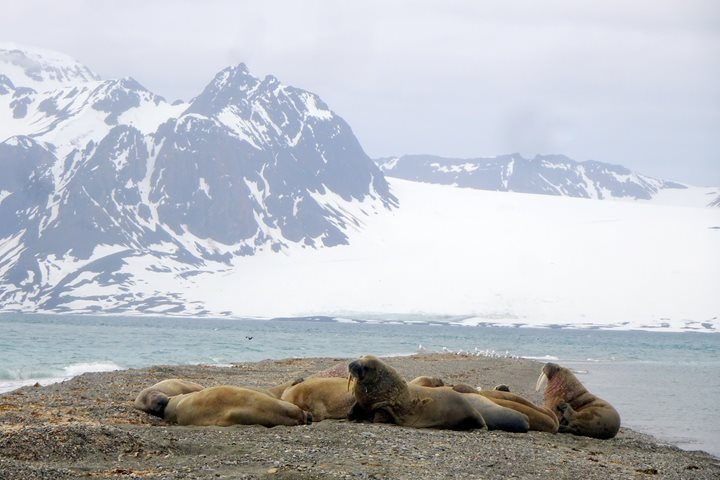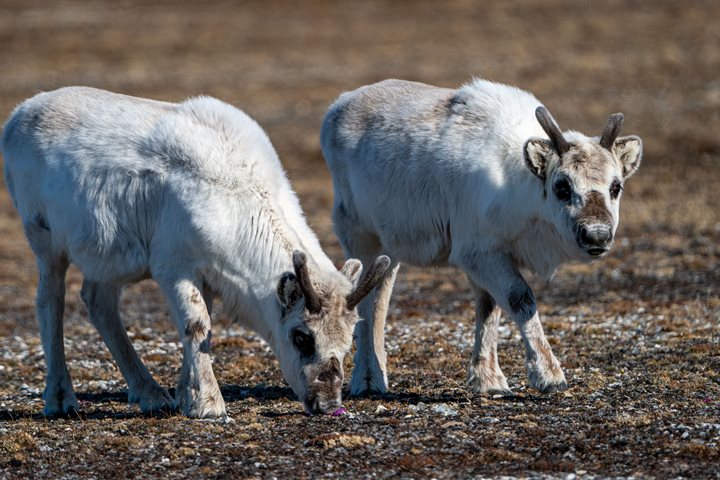Today was our reindeer and walrus day! Both were on the verge to extinction in the Barents Sea region because of the overhunting but were protected in the very last moment and are today a good example how protection and wildlife management can be successful. In 1970 Norway set plans to make Svalbard to become one of the best-managed wildlife areas in the world. They created protected closed areas, nature reserves, and national parks. Today many of the species encountered in Svalbard, in the High Arctic, are found in good numbers and healthy populations, which was impossible only 20 - 25 years ago—a great story of success.
Reindeer in Svalbard were heavily overhunted, and the very first decision made by Norway, as they gained full jurisdiction of the area in 1925, was to ban hunting of the reindeer. Today more than 10,000 animals roams the archipelago, but they are never found anywhere in herds or great numbers. These reindeer, a unique subspecies only found in Svalbard, are short-legged as the snow is not very deep here. The area is the bottleneck through the winter, and it is instead the cold winds and a barren, open landscape with which the reindeer must contend. The wind is at the same time important to sweep away the snow and create access to lichens, the main food through the dark and cold winter. Now it is just passed midsummer, grass and plants are rapidly shooting up, and for about two month the reindeer need to rebuild a layer of fat to make it through the next winter.
Walrus are also much about fat; an animal heavily hunted for its blubber since the first Europeans found Spitzbergen 1596. They gained full protection here at Svalbard first 1952 and more or less at the same time in nowadays Arctic Russia. Around Svalbard literally no walrus remained, but a small population at Franz Josef Land and northern Novaya Zemlya was able to slowly rebuild the population in the Barents Sea. Now it is estimated that more than 3,000 animals are found in the northern Barents Sea region, and over the last decade more and more females with calves has been seen around Svalbard.
This morning was allocated for two new events, a mushy tundra hike on the western side of Egdeøya and kayaking. As we approached Årdalsnuten, the sea was like a mirror and these events are something you learn to take to your advantage in the Polar Regions. Here weather is always something that can—even in the height of the summer—shift between blizzards or into rain and fog but also a beautiful summer day. Rapidly you learn it is not really the temperature that is of any importance; it is wind or no wind that makes the difference. Today it was ideal to be out on the tundra or on the water.
Soon after breakfast the scout team went ashore to secure the area from polar bears at Habinichtbukta. At least they did not see any and the hikers arrived to spread out on the wet and mushy tundra. Here reindeer are plentiful in small groups busy constantly grazing. The birders enjoyed nice display with red phalaropes, red-necked loons, long-tailed ducks. Some found huge polar bear tracks in the mud by the creek. At least we know they have been here. Water activity was also offered for anybody who wanted to explore the bay from a kayak.
During lunch and early afternoon we steamed further north and at Kapp Lee we sighted a pile of walrus hauled out on the beach by the old cabin. Here the story of how man arrived and stripped the resources is told. Piles of walrus bones and skulls are littered all over the beach. Now the walrus have returned to the same haul-out site used by generations before and can rest and digest after long feeding runs. A walrus can consume several thousand clams per day and will be out feeding for three to nine days.
During dinner we slowly made it through Freemansundet, separating Edgeøya and Barentsøya, and by breakfast time tomorrow we hope to be in the Arctic pack ice.







